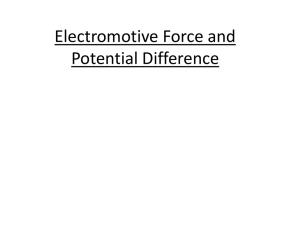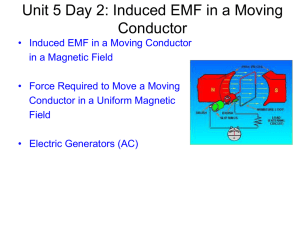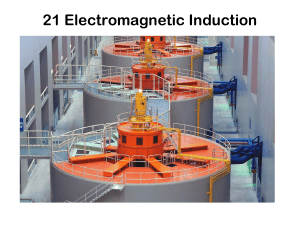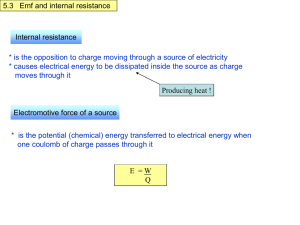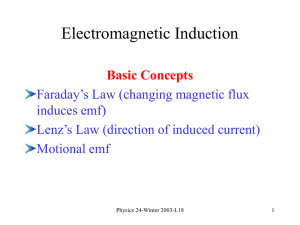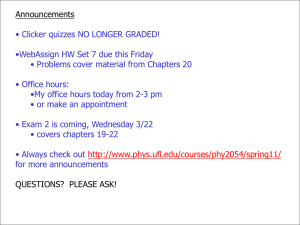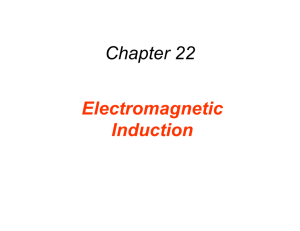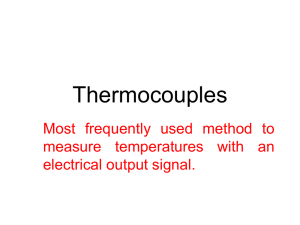Back emf.
advertisement
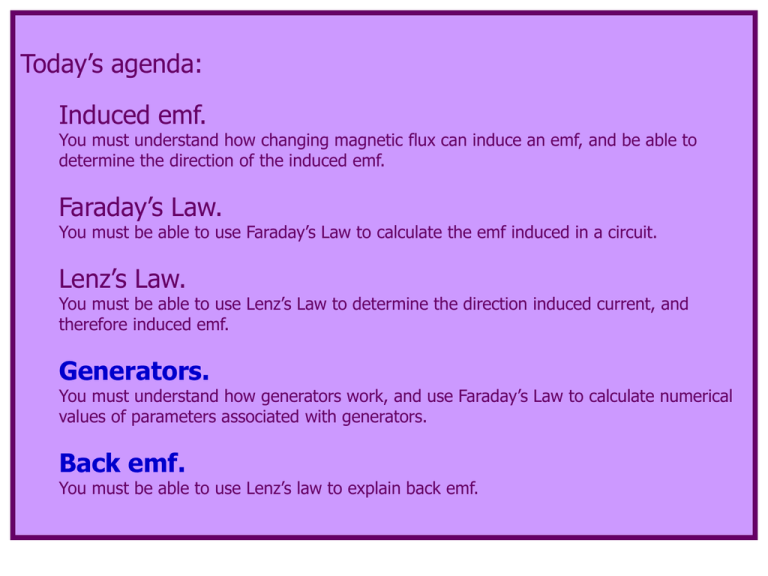
Today’s agenda: Induced emf. You must understand how changing magnetic flux can induce an emf, and be able to determine the direction of the induced emf. Faraday’s Law. You must be able to use Faraday’s Law to calculate the emf induced in a circuit. Lenz’s Law. You must be able to use Lenz’s Law to determine the direction induced current, and therefore induced emf. Generators. You must understand how generators work, and use Faraday’s Law to calculate numerical values of parameters associated with generators. Back emf. You must be able to use Lenz’s law to explain back emf. electric motors and web applets Generator: source of mechanical energy rotates a current loop in a magnetic field, and mechanical energy is converted into electrical energy. Electric motor: a generator “in reverse.” Current in loop in magnetic field gives rise to torque on loop. A dc motor animation is here. Details about ac and dc motors at hyperphysics. Other useful animations here. True Fact you didn’t know: all electrical motors operate on smoke. Every motor has the correct amount of smoke sealed inside it at the factory. If this smoke ever gets out, the motor is no longer functional. I can even provide the source of this true information. http://www.xs4all.nl/~jcdverha/scijokes/2_16.html#subindex detailed look at a generator (if time permits) Let’s begin by looking at a simple animation of a generator. http://www.wvic.com/how-gen-works.htm brush Here’s a “freeze-frame.” Normally, many coils of wire are wrapped around an armature. The picture shows only one. slip ring Brushes pressed against a slip ring make continual contact. The shaft on which the armature is mounted is turned by some mechanical means. Disclaimer: there are some oversimplifications in this analysis which an expert would consider “errors.” Anyone who is an expert at generators is invited to help me correct these slides! Let’s look at the current direction in this particular freezeframe. B is down. Coil rotates counterclockwise. Put your fingers along the direction of movement. Stick out your thumb. Rotate your hand until your palm points in the direction of B. Your thumb points in the direction of conventional current. One more thing… This wire… …connects to this ring… …so the current flows this way. Another way to generate electricity with hamsters: give them little magnetic collars, and run them through a maze of coiled wires. http://www.xs4all.nl/~jcdverha/scijokes/2_16.html#subindex Later in the cycle, the current still flows clockwise in the loop… …but now this* wire… …connects to this ring… …so the current flows this way. Alternating current! ac! Without commutator—“dc.” *Same wire as before, in different position. Back emf. You must be able to use Lenz’s law to explain back emf. back emf (also known as “counter emf”) (if time permits) A changing magnetic field in wire produces a current. A constant magnetic field does not. We saw how changing the magnetic field experienced by a coil of wire produces ac current. But the electrical current produces a magnetic field, which by Lenz’s law, opposes the change in flux which produced the current in the first place. http://campus.murraystate.edu/tsm/tsm118/Ch7/Ch7_4/Ch7_4.htm The effect is “like” that of friction. The counter emf is “like” friction that opposes the original change of current. Motors have many coils of wire, and thus generate a large counter emf when they are running. Good—keeps the motor from “running away.” Bad—”robs” you of energy. If your house lights dim when an appliance starts up, that’s because the appliance is drawing lots of current and not producing a counter emf. When the appliance reaches operating speed, the counter emf reduces the current flow and the lights “undim.” Motors have design speeds their engineers expect them to run at. If the motor runs at a lower speed, there is less-thanexpected counter emf, and the motor can draw more-thanexpected current. If a motor is jammed or overloaded and slows or stops, it can draw enough current to melt the windings and burn out. Or even burn up. Two brief examples (for you to review outside of lecture): Induced emf on an airplane wing. Blood flow measurement. Please study these examples on your own! Example: An airplane travels 1000 km/h in a region where the earth’s field is 5x10-5 T and is vertical. What is the potential difference induced between the wing tips that are 70 m apart? v The electrons “pile up” on the left hand wing of the plane, leaving an excess of + charge on the right hand wing. The equation for at the bottom of slide 10 gives the potential difference. (You’d have to derive this on a test.) ε =B v ε = 5×10-5 T 70 m 280 m/s ε = 1V v + No danger to passengers! (But I would want my airplane designers to be aware of this.) Example: Blood contains charged ions, so blood flow can be measured by applying a magnetic field and measuring the induced emf. If a blood vessel is 2 mm in diameter and a 0.08 T magnetic field causes an induced emf of 0.1 mv, what is the flow velocity of the blood? =Bℓv v = / (B ℓ) If B is applied to the blood vessel, then B is to v. The ions flow along the blood vessel, but the emf is induced across the blood vessel, so ℓ is the diameter of the blood vessel. v = (0.1x10-3 V) / ( (0.08 T)(0.2x10-3 m) ) v = 0.63 m/s
